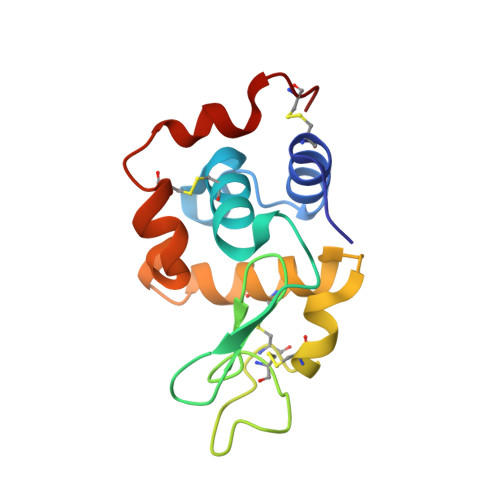Steric hindrance and charge influence on the cytotoxic activity and protein binding properties of diruthenium complexes.
Teran, A., Ferraro, G., Imbimbo, P., Sanchez-Pelaez, A.E., Monti, D.M., Herrero, S., Merlino, A.(2023) Int J Biol Macromol 253: 126666-126666
- PubMed: 37660867
- DOI: https://doi.org/10.1016/j.ijbiomac.2023.126666
- Primary Citation of Related Structures:
8PH5, 8PH6, 8PH7, 8PH8 - PubMed Abstract:
Paddlewheel diruthenium complexes are being used as metal-based drugs. It has been proposed that their charge and steric properties determine their selectivity towards proteins. Here, we explore these parameters using the first water-soluble diruthenium complex bearing two formamidinate ligands, [Ru 2 Cl(DPhF) 2 (O 2 CCH 3 ) 2 ], and two derivatives, [Ru 2 Cl(DPhF)(O 2 CCH 3 ) 3 ] and K 2 [Ru 2 (DPhF)(CO 3 ) 3 ] (DPhF - = N,N'-diphenylformamidinate), with one formamidinate. Their protein binding properties have been assessed employing hen egg white lysozyme (HEWL). The results confirm the relationship between the type of interaction (coordinate/non-coordinate bonds) and the charge of diruthenium complexes. The crystallization medium is also a key factor. In all cases, diruthenium species maintain the M-M bond and produce stable adducts. The antiproliferative properties of these diruthenium complexes have been evaluated on an eukaryotic cell-based model. Our data show a correlation between the number of the formamidinate ligands and the anticancer activity of the diruthenium derivatives against human epithelial carcinoma cells. Increased cytotoxicity may be related to increased steric hindrance and Ru 2 5+ core electronic density. However, the effect of increasing the lipophilicity of diruthenium species by introducing a second N,N'-diphenylformamidinate must be also considered. This work illustrates a systematic approach to shed light on the relevant properties of diruthenium compounds to design metal-based metallodrugs and diruthenium metalloenzymes.
Organizational Affiliation:
MatMoPol Research Group, Department of Inorganic Chemistry, Faculty of Chemical Sciences, Complutense University of Madrid, Avda. Complutense s/n, 28040 Madrid, Spain.
















